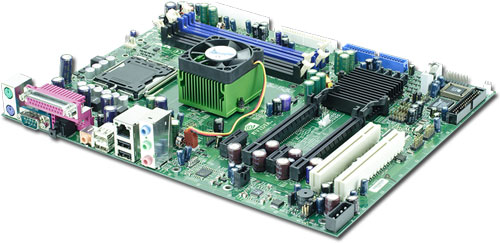Nvidia has announced that it has introduced an Nforce 4 board which supports dual graphics cards in SLI, using 16 PCI Express lanes for each card.
The previous generation of Nforce 4, for both Intel and AMD, has used 1 graphics card at 16 lanes or 2 graphics cards at 8 each, because the Nforce southbridge couldn't support any more lanes.
However, Nvidia has had this technology for a while in its Nforce Pro chipset, which it ships to professionals using Opteron systems and Quadro graphics cards.
It's not exactly clear what benefit this will offer, since games are nowhere near really exploiting the maximum bandwidth that even 8x PCI Express can offer. Applications which make use of lots more bandwidth, like video editing, aren't accelerated by SLI.
However, over at the Inquirer, Charlie points out an interesting point that we hadn't spotted. In the Intel implementation, memory traffic is passed from the northbridge to the GPU directly, unlike the AMD version. Could this small advantage finally give Intel a bit of a leg-up when it comes to gaming? We'll be waiting for benchmarks.
What Nvidia has done is attracted Dell's attention, and Dell is the first system builder to ship the chipset. Significantly, it's the first non-Intel chipset that Dell has ever shipped.
Whilst Dell can't hope to ship too many of these systems, it's a very good face-saver for them - and even better for Nvidia, who get a foot in the door. It all goes to show how important SLI is, when Dell feels it simply has to have a system out there that supports it.
This does put Crossfire down a notch, since it only supports dual 8x lanes - meaning it's playing catchup, even before release. However, initial benchmarks of Crossfire boards in single-card setups do seem to suggest that they're pretty fast - we're still waiting to get our hands on one to find out.
Do you think x16 will offer much of a benefit? Tell us your thoughts!



The previous generation of Nforce 4, for both Intel and AMD, has used 1 graphics card at 16 lanes or 2 graphics cards at 8 each, because the Nforce southbridge couldn't support any more lanes.
However, Nvidia has had this technology for a while in its Nforce Pro chipset, which it ships to professionals using Opteron systems and Quadro graphics cards.
It's not exactly clear what benefit this will offer, since games are nowhere near really exploiting the maximum bandwidth that even 8x PCI Express can offer. Applications which make use of lots more bandwidth, like video editing, aren't accelerated by SLI.
However, over at the Inquirer, Charlie points out an interesting point that we hadn't spotted. In the Intel implementation, memory traffic is passed from the northbridge to the GPU directly, unlike the AMD version. Could this small advantage finally give Intel a bit of a leg-up when it comes to gaming? We'll be waiting for benchmarks.
What Nvidia has done is attracted Dell's attention, and Dell is the first system builder to ship the chipset. Significantly, it's the first non-Intel chipset that Dell has ever shipped.
Whilst Dell can't hope to ship too many of these systems, it's a very good face-saver for them - and even better for Nvidia, who get a foot in the door. It all goes to show how important SLI is, when Dell feels it simply has to have a system out there that supports it.
This does put Crossfire down a notch, since it only supports dual 8x lanes - meaning it's playing catchup, even before release. However, initial benchmarks of Crossfire boards in single-card setups do seem to suggest that they're pretty fast - we're still waiting to get our hands on one to find out.
Do you think x16 will offer much of a benefit? Tell us your thoughts!




MSI MPG Velox 100R Chassis Review
October 14 2021 | 15:04






Want to comment? Please log in.